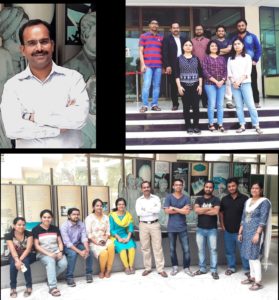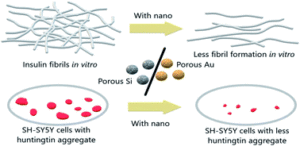We are very pleased to introduce Dulal Senapati, corresponding author of the paper ‘Impact of porous nanomaterials on inhibiting protein aggregation behaviour‘. His article has been very well received and handpicked by our reviewers and handling editors as one of our February HOT articles. Dulal told us more about the work that went into this article and what he hope to achieve in the future. You can find out more about his article below and find more HOT articles in our online collection.
Meet the authors
Dr. Dulal Senapati is an Associate Professor in the Chemical Sciences Division (CSD) at the Saha Institute of Nuclear Physics (SINP), Homi Bhabha National Institute (HBNI), Kolkata, INDIA. He earned his Ph.D. in 2005 with Prof. Puspendu K. Das at the Indian Institute of Science (IISc), Bengaluru. After finishing his Ph.D., he immediately joined as a Postdoctoral Fellow at the Georgia Institute of Technology, USA in the laboratory of Prof. Robert M. Dickson and continued till 2008. In 2008, he moved to Jackson State University, USA to pursue his second Postdoctoral research in the laboratory of Prof. P. C. Ray and continued till 2013. In 2013, he joined SINP as an Associate Professor-‘E’ and was promoted to Associate Professor-‘F’ in 2018. The central theme of Dr. Senapati’s laboratory (Nanophotonics Laboratory) is to design, characterizing, and finding applications of defect enriched anisotropic plasmonic, magnetic, and magnetoplasmonic nanomaterials in the field of sensing, diagnosis, catalysis, and therapeutics. Details of his publication, citation, and h-index are listed in: https://scholar.google.co.in/citations?user=0b5q6hAAAAAJ&hl=en.
Could you briefly explain the focus of your article to the non-specialist (in one or two sentences only) and why it is of current interest?
Of late, several diseases caused by “misfolding” of one or more key proteins are drawing attention to biologists. Of these, neurodegenerative diseases like Huntington’s, Alzheimer’s, Parkinson’s etc. are of special interest because any drug which would prevent these misfolded proteins to aggregate, must also cross the blood-brain-barrier to reach the brain. The focus of our article is to find a way to prevent non-specific protein aggregation by interfering with their physical properties, especially those that trigger misfolding and cause the disease. In this research work we used non-toxic and biocompatible nanomaterials, with potentials to act as vehicles to cross the barrier, for preventing their aggregation and thereby inhibiting these diseases. This study could be fruitful to formulate nanotherapeutic drugs for future clinical applications.
How big an impact could your results potentially have?
This work could have huge impact in the field of Nanomedicine. The assay is already shown to be effective in cellular model, and in future we have a plan to validate it in Alzheimer’s diseases animal model. Once established, this work has the potential to revolutionize the use of nanotherapeutic drugs for future clinical applications of neurodegenerative diseases.
Could you explain the motivation behind this study?
The main motivation behind this work was to understand the role of nanoparticles, especially porous nanomaterials to control aggregation of protein which may cause different neurodegenerative diseases. Though the literature is rich in the therapeutic applications of non-porous inorganic nanoparticles, the role of corresponding porous nanomaterials has not been explored to the same extent. Porous nanomaterials are more effective due to their highly controllable and isotropic nature of large accessible pore size, and easy release of incorporated materials from their pores.
In your opinion, what are the key design considerations for your study?
Following are the two key design considerations for our study:
(i) Designing of bio compatible and cost effective nanomaterials to achieve the desired structure.
(ii) To control the fibrillation process of model protein aggregates in presence of porous nanomaterials at pH 1.8.
Which part of the work towards this paper proved to be most challenging?
(i) synthesis of monodispersed porous nanomaterials with uniform pore diameter distribution.
(ii) High contrasted images of aggregated Insulin in presence of porous nano-silica (PNS).
(iii) Stable cell culture of SHSY5Y human cell line (Neuroblastoma of neuronal origin).
What aspect of your work are you most excited about at the moment?
We are extremely excited by finding out a cheap and nontoxic way to restrict the protein aggregation which we potentially can use to formulate nanotherapeutic drugs for future clinical applications.
What is the next step? What work is planned?
Next step is to validate our assay in Alzheimer’s disease animal model. This may help revolutionize the formulation of nanotherapeutic drugs for future clinical applications.
Impact of porous nanomaterials on inhibiting protein aggregation behaviour
Munmun Bardhan, Sandip Dolui, Siddhi Chaudhuri, Uttam Paul, Gaurav Bhattacharjee, Manorama Ghosal, Nakul C. Maiti, Debashis Mukhopadhyay and Dulal Senapati
RSC Adv., 2021,11, 3354-3362
DOI: 10.1039/D0RA10927D, Paper
 Submit to RSC Advances today! Check out our author guidelines for information on our article types or find out more about the advantages of publishing in a Royal Society of Chemistry journal.
Submit to RSC Advances today! Check out our author guidelines for information on our article types or find out more about the advantages of publishing in a Royal Society of Chemistry journal.
Keep up to date with our latest HOT articles, Reviews, Collections & more by following us on Twitter. You can also keep informed by signing up to our E-Alerts.












